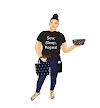Embarking on a sewing journey can be exhilarating BUT choosing the right fabric is often a daunting task for beginners. After all, you are just learning to piece a project together!
I have received many questions asking about different types of fabrics. Understanding different types is crucial because it directly impacts the outcome of your project—whether you're crafting a simple tote bag or an elegant dress. (I am sure you won't be sewing an elegant dress, YET, if you are on my site), but here’s a guide to help you start to figure it all out.... some common fabric types:
Cotton: Most commonly used. It is versatile and breathable and a go-to fabric for beginners. It’s easy to sew and comes in various weights, from lightweight to heavier canvas (perfect for bags).
Linen: Crisp texture and cool feel, linen is perfect for summer garments. It wrinkles easily but adds a relaxed, natural aesthetic to your creations.
Polyester: A synthetic fabric that’s durable, wrinkle-resistant, and often blended with other fibers like cotton. Great for projects that need structure and easy care.
Silk: A luxurious and delicate, silk drapes beautifully and adds elegance to formal wear. It requires careful handling due to its delicacy. Most are machine wash only. Be sure to check care instructions before picking this fabric for a project.
Wool: Ideal for cooler months. Wool is warm, insulating, and comes in different textures like tweed or felt. It’s a bit more challenging to sew but you can grab a walking foot! It's worth the effort for tailored pieces.
Knits: Stretchy and comfortable, knits include fabrics like jersey and interlock. They’re forgiving and great for making casual wear or activewear.
Denim: Sturdy and durable. We all know denim is synonymous with jeans but can also be used for jackets, skirts, and bags. (Great way to recycle your old jeans by the way!) It’s heavy and requires strong needles and thread. Read the back of the pack of needles!
Velvet: Soft and luxurious, velvet adds texture and depth to garments. It’s trickier to sew due to its pile, so beginners might want to practice before using it for complex projects.
Chiffon: Sheer and lightweight, chiffon is commonly used for elegant blouses and evening wear. It requires special handling and often needs lining. I haven't ventured with this fabric however because it is too expensive for me to justify purchasing when I screw it up! : ) Besides, anything fancy I may wear would need to be purchased from a store. I sew things but not wearable, fancy items!
With all of that being said........
When choosing fabric, consider not just the aesthetic but also its practical aspects. Think about how it drapes, its stretch (or lack thereof <-- big NO for me), and how it behaves when washed or ironed. We're all told before starting a project, test your fabric by sewing a small sample to get a feel for its behavior but at that point, I would have already purchased the fabric! I rub it and get the feel for it at the store, boosting my confidence and envisioning my final creation turns out just as I imagine it. That's it. I don't prewash the fabric if it is not a wearable project. I just wing it and hope for the best!
Exploring different fabrics is an exciting part of the sewing journey. Don’t hesitate to experiment and learn from each project. You are bound to mess up and learn for the next time! Before you know it, you’ll develop a keen eye for selecting the perfect fabric for every sewing endeavor. Just go with it! You can do it! You go this!
Happy sewing!
Nikki


0 Comments